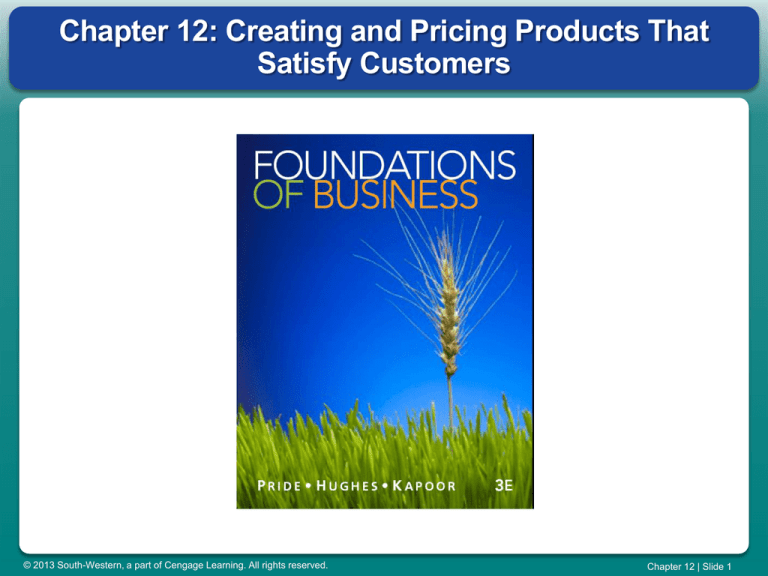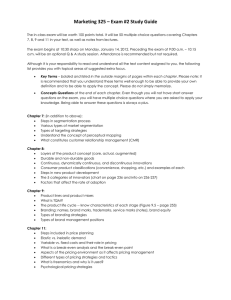
Chapter 12: Creating and Pricing Products That
Satisfy Customers
© 2013 South-Western, a part of Cengage Learning. All rights reserved.
Chapter 12 | Slide 1
Learning Objectives
1. Explain what a product is and how products are
2.
3.
4.
5.
classified.
Discuss the product life cycle and how it leads to
new product development.
Define product line and product mix and distinguish
between the two.
Identify the methods available for changing a
product mix.
Explain the uses and importance of branding,
packaging, and labeling.
© 2013 South-Western, a part of Cengage Learning. All rights reserved.
Chapter 12 | Slide 2
Learning Objectives (cont.)
6.
7.
8.
9.
10.
Describe the economic basis of pricing and the means
by which sellers can control prices and buyers’
perceptions of prices.
Identify the major pricing objectives used by
businesses.
Examine the three major pricing methods that firms
employ.
Explain the different strategies available to companies
for setting prices.
Describe three major types of pricing associated with
business products.
© 2013 South-Western, a part of Cengage Learning. All rights reserved.
Chapter 12 | Slide 3
Classification of Products
Consumer Product Classifications
Business Product Classifications
© 2013 South-Western, a part of Cengage Learning. All rights reserved.
Chapter 12 | Slide 4
The Product Life-Cycle
Stages of the Product Life-Cycle
1. Introduction
2. Growth
3. Maturity
4. Decline
Using the Product Life-Cycle
© 2013 South-Western, a part of Cengage Learning. All rights reserved.
Chapter 12 | Slide 5
Product Line and Product Mix
The Product Line and Product Mix
Managing Existing Products
1. Product Modifications
2. Line Extensions
Deleting Products
Developing New Products
1. Idea Generation
2. Screening
3. Concept Testing
4. Business Analysis
5. Product Development
6. Test Marketing
7. Commercialization
Why Do Products Fail?
© 2013 South-Western, a part of Cengage Learning. All rights reserved.
Chapter 12 | Slide 6
Branding, Packaging, and Labeling
What Is a Brand?
Types of Brands
Benefits of Branding
Choosing and Protecting a Brand
Branding Strategies
Brand Extensions
Packaging
1. Packaging Functions
2. Package Design Considerations
Labeling
© 2013 South-Western, a part of Cengage Learning. All rights reserved.
Chapter 12 | Slide 7
Pricing Products
The Meaning and Use of Price
Supply and Demand Affects Prices
Price and Non-Price Competition
Buyers’ Perceptions of Price
© 2013 South-Western, a part of Cengage Learning. All rights reserved.
Chapter 12 | Slide 8
Pricing Objectives
Survival
Profit Maximization
Target Return on Investment
Market-Share Goals
Status-Quo Pricing
© 2013 South-Western, a part of Cengage Learning. All rights reserved.
Chapter 12 | Slide 9
Pricing Methods
Cost-Based Pricing
Demand-Based Pricing
Competition-Based Pricing
© 2013 South-Western, a part of Cengage Learning. All rights reserved.
Chapter 12 | Slide 10
Pricing Strategies
New-Product Pricing
Differential Pricing
Psychological Pricing
Product-Line Pricing
Promotional Pricing
© 2013 South-Western, a part of Cengage Learning. All rights reserved.
Chapter 12 | Slide 11
Pricing Business Products
Geographic Pricing
Transfer Pricing
Discounting
© 2013 South-Western, a part of Cengage Learning. All rights reserved.
Chapter 12 | Slide 12





